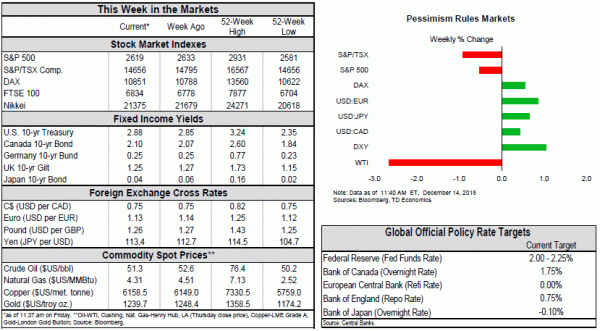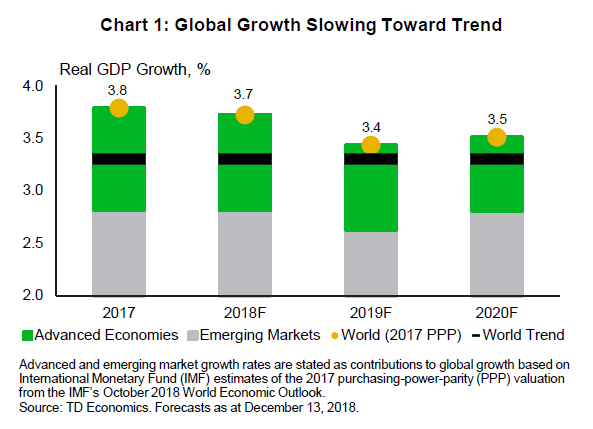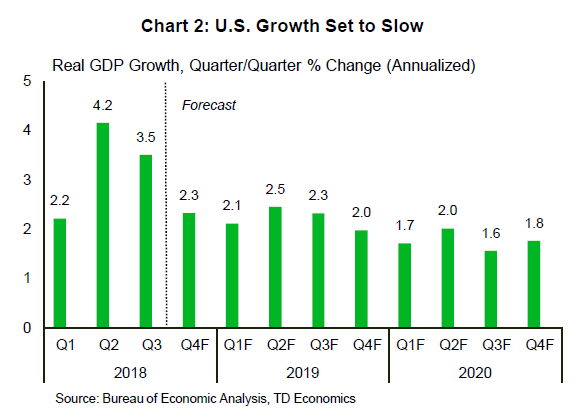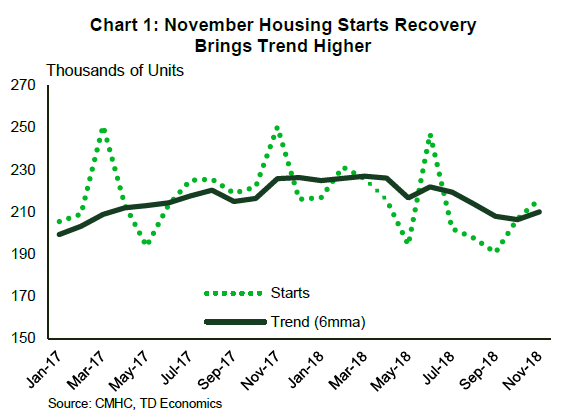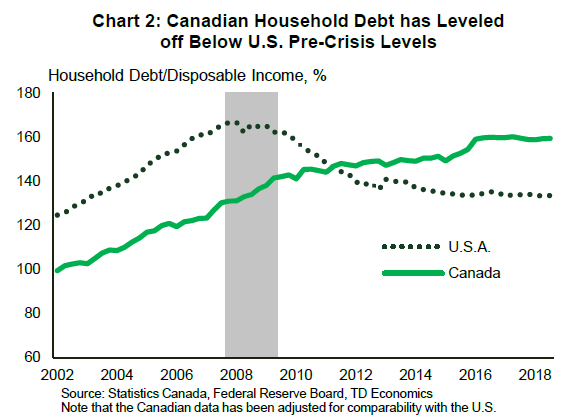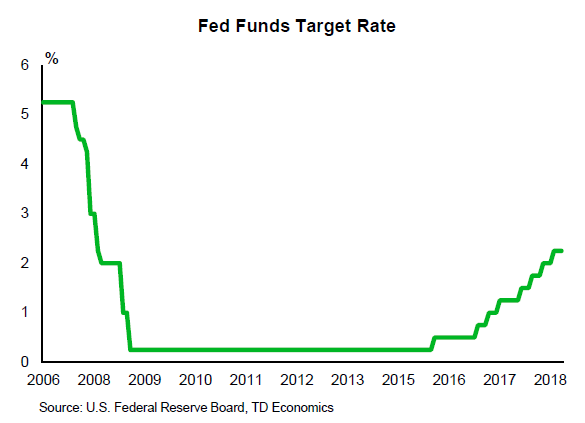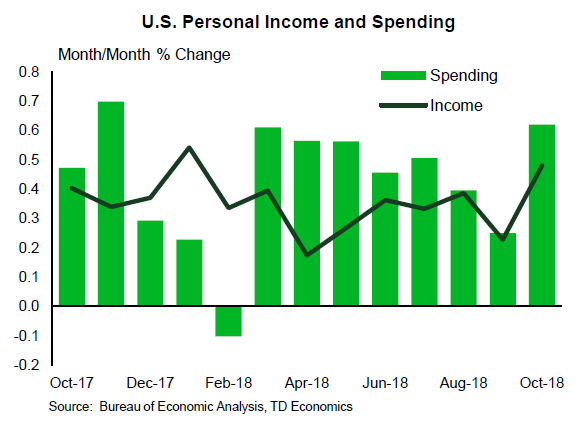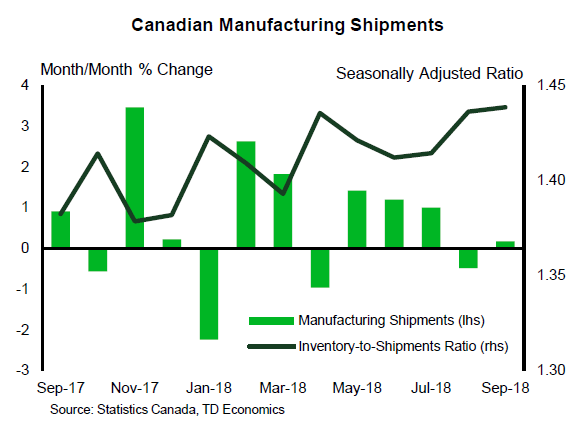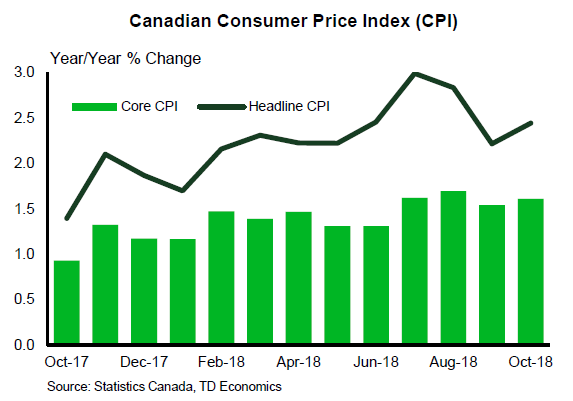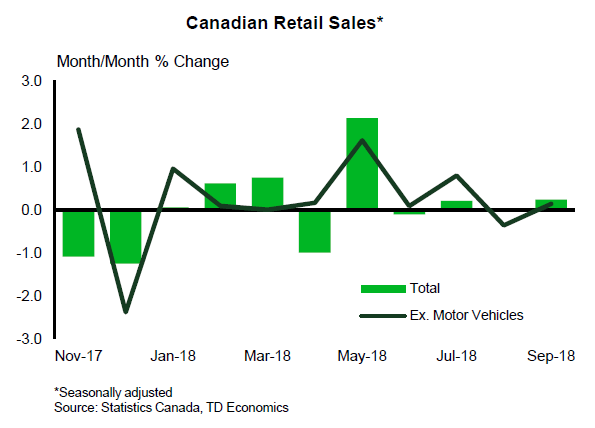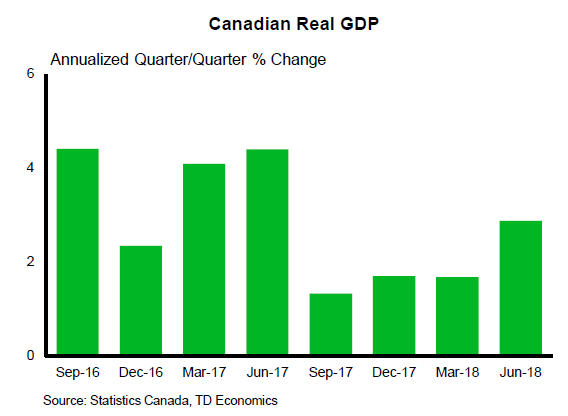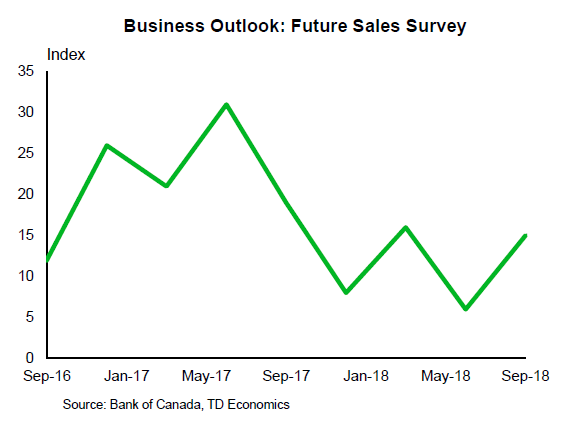U.S. Highlights
- After some optimism early in the week, financial market sentiment soured as focus shifted back to fears of an escalation in trade tensions, Brexit uncertainty, and a potential economic downturn in 2019.
- The U.S. consumer remained unbowed in November, with consumer spending now tracking above 3% annualized in Q4. Inflation has cooled in line with oil prices, which should help to support real spending going forward.
- The FOMC makes its final decision of 2019 next week, and a hike is universally expected. We will be watching closely to see how members’ views have changed about how many hikes will ultimately be required in this cycle.
Canadian Highlights
- Canadian builders broke ground on a few more homes in November, as starts beat expectations, reaching 216k in November, a 4.4% increase on the month.
- This week also revealed that Canadians are more stretched than previously thought. Statistics Canada reported the household debt-to-income ratio at 177.5% in Q3, revising the level up markedly on downward revisions to household incomes.
- TD Economics’ revised quarterly forecast sees real GDP growth slowing from 2.1% this year to 1.8% in 2019 in the face of mounting headwinds, notably oil sector disruptions.
U.S. – “Bah! Humbug!”
After some optimism early in the week, supported by positive headlines about the lessening of U.S.-China trade tensions, sentiment turned sour to end the week. Markets seem to be channeling Dickens’s curmudgeonly character Ebenezer Scrooge, saying “Bah! Humbug!” to any good news that comes along. Markets are down roughly 10% in the fourth quarter of this year as investors fret about prospects for 2019, focusing on the potential for escalating trade tensions, uncertainty about the path of Brexit, and a potential economic downturn.
Our latest outlook did feature a small downgrade to global growth (Chart 1). However, the selloff in global risk assets in the fourth quarter has been outsized relative to the magnitude of the economic slowdown. The selloff likely reflects the build-up of unresolved global risks, coupled with a delayed adjustment in growth expectations from lofty levels. Taking a step back from the downturn in equity markets, there are few signs that the economic expansion is nearing an end, other than the fact that the expansion is approaching the longest on record. One worry is that negative sentiment can become self-fulfilling (see our Perspective). We remain vigilant in monitoring signals of an impending downturn, such as yield curves, business confidence, risk-assets, and labor market conditions.
Financial market pessimism certainly hasn’t yet filtered down to the U.S. consumer. The holiday shopping season appears to have gotten off to a good start in November, as retail sales were up more than expected, on top of upward revisions to October. In our latest U.S. Outlook, we also expect the overall economy to moderate towards a sustainable pace in 2019 (Chart 2). This process is already underway in the fourth quarter, where growth is tracking 2.3% after averaging 3.5% through the middle of the year. However, the consumer has more momentum. Today’s retail sales report places expectations for consumer spending in the fourth quarter to 3.5%, from our recently published 2.9%.
The consumer is in pretty good shape. The job market is strong and inflation is contained. Economy-wide growth in wages and salaries has averaged roughly 4% over the past six months. And, headline inflation has cooled in line with lower oil prices. CPI inflation was at 2.2% year-on-year in November’s data. Our forecast is for inflation to remain around that level through 2019. That sets the consumer up for some decent real income gains. Therefore, we expect consumer spending to slow only modestly in 2019, as the windfall from tax cuts fades, but still running at a very healthy 2-2 ½% clip in real terms.
Overall, the U.S. economy is strong, and the Federal Reserve is well justified in raising rates another quarter point at its meeting next Wednesday. The real question is how the FOMC’s views have changed about how much further rates need to rise. Given the fairly benign inflation backdrop recently, we expect the Fed to hike rates more gradually in 2019.
Canada – Stretch That Loonie (You Have To)
This week saw generally soft performances across major markets, with the S&P/TSX composite index looking to end the week slightly lower. This movement comes in spite of another constructive week for Canadian energy prices, as both Albertan heavy and light benchmarks held onto recent gains.
The reversal of pricing pressures in the wake of government-mandated curtailment plans has been remarkable. In a few short weeks, the Western Canada Select heavy oil benchmark has gone from the doldrums to among the best performing commodities this year. If current pricing holds, this contract is set to end 2018 more than 5% above where it began, making it one of just a few major commodities set to end the year up.
Away from markets, it was a relatively light week in terms of Canadian economic data before next week’s pre-holiday deluge. Housing starts were released early in the week, with Canadian builders breaking ground on 216k new units (Chart 1). This came in ahead of market expectations, and was strong enough to bend the trend measure upwards. Encouragingly, while much of the gain came from the volatile multi-family segment, single-detached starts also rose a healthy 7.8%.
Less encouraging was Statistics Canada’s release of national wealth accounts. We got a preview of what was coming with the Q3 GDP figures, which reported a household saving rate of just 0.9%, revised down by more than two percentage points. This revision came from updated tax data that revealed a much weaker household income story than initially reported. This also means that households are more stretched than previously thought.
In the event, even as borrowing decelerated slightly, the household debt-to-income ratio rose to 177.5%, meaning households owe, on average, $1.78 for every dollar of disposable income. This is roughly four percentage points higher than what had been reported previously, on a like-for-like basis.
Certain to garner much attention, it may be instructive to compare this with where things sat in the U.S. pre-crisis. Once we adjust the data for comparability, we see that not only are debt ratios lower than they were in the U.S. pre-crisis, but the dynamics are different as well, with the Canadian ratio effectively flat over the past two years (Chart 2).
That said, there is no arguing that household debt levels are anything but high, and stretched Canadian households are a key factor holding back the pace of consumer spending in our Quarterly Economic Forecast. The impact of oil curtailments, alongside headwinds such as the closure of GM’s Oshawa plant, is a mark-down of growth expectations. We now anticipate that output growth will decelerate from 2.1% this year to 1.8% next, before picking up again in 2020.
U.S.: Upcoming Key Economic Releases
U.S. FOMC Statement
Release Date: December 19, 2018
Previous: 2.25%
TD Forecast: 2.50%
Consensus: 2.50%
TD and the wider market look for the Fed to hike to 2.50% in December. Changes to the FOMC statement language should remove the last vestiges of forward guidance, making policy even more data dependent and hinting that policy may be approaching the end of the cycle. In his press conference we expect Chair Powell to continue to sound cautiously optimistic on the outlook and to try to calm market concerns about over-tightening. It will only take one FOMC participant to move the median dots in most years; we think a decline in the 2019 median dot to two hikes from three is slightly more likely than staying put. Conversely, we expect the median longer-run dot to remain at 3%. The overall tone of the meeting should be modestly dovish.
U.S. Personal Income & Spending – October
Release Date: December 21, 2018
Previous: Income 0.5%; spending 0.6%
TD Forecast: Income 0.4%; spending 0.3%
Consensus: Income 0.3%; spending 0.3%
We expect core PCE inflation to rise 0.2% m/m, pushing the y/y rate higher to 1.9%. But the past disappointment and downward revisions will still leave Q4 core inflation tracking below FOMC estimates at 1.9%, with risk for 1.8%. On a more upbeat note, we expect a strong showing for personal spending (0.4%), reinforcing another robust quarter for consumer spending above 3%.
Canada: Upcoming Key Economic Releases
Canadian Manufacturing Sales – October
Release Date: December 18, 2018
Previous: 0.2%
TD Forecast: -0.8%
Consensus: N/A
Manufacturing sales are forecast to decline by 0.8% in October as a sharp pullback in petroleum production outweighs higher durable goods sales. The energy sector lost roughly 300k bpd of refining capacity in early October, roughly 20% of the Canadian total, due to shutdowns at the Irving facility in Saint John which will provide a significant headwind to manufacturing activity as a whole. Motor vehicles should provide a key offset on higher reported production figures, while a rebound in machinery manufacturing could add another source of strength after registering the largest decline since 2012 in the month before the CUSMA agreement. Real manufacturing sales should see a slightly larger decline on higher factory prices and should energy provide the primary source of downside we would be inclined to fade any reaction given a likely rebound next month.
Canadian CPI – November
Release Date: December 19, 2018
Previous: 0.3% m/m, 2.4% y/y
TD Forecast: -0.4% m/m, 1.7% y/y
Consensus: N/A
November inflation is set to moderate significantly, from 2.4% to 1.7%. The main driver is energy prices, with gasoline prices down 10% m/m on the oil rout. That pushes the energy component into deflationary territory (-1.4% y/y vs +7.9% y/y previously). Food prices should provide a partial offset but beyond that the picture is not upbeat. We look for the ex-food and energy index to slide back below 2%, partially reflecting mean reversion from the strength in October. We also eye weakness in travel services and airfares, which skew risks to the downside. The recent currency depreciation (-4.5% since early October) is a net tailwind but we don’t expect a noticeable lift to materialize until next month. Looking ahead, headline CPI should fall further in December on the back of lower oil prices, leaving inflation tracking below BoC’s forecasts at 2.0% in Q4 (BoC: 2.3%).
Canadian Retail Sales – October
Release Date: December 21, 2018
Previous: 0.2%, ex-auto: 0.1%
TD Forecast: 0.4%, ex-auto: 0.2%
Consensus: N/A
TD looks for retail sales to rise by 0.4% in October on further gains in motor vehicle sales along with more modest increase in ex-auto sales. Preliminary data, while volatile, showed higher sales for both trucks and passenger vehicles although ongoing softness in home sales calls into question the durability of any gains. However, residential construction has picked up through Q4 which should support a rebound in building materials following a cumulative 4% drop over the last three months. Gasoline station sales should provide a slight drag on the headline print owing to lower prices at the pump although higher prices as a whole will leave real retail sales to underperform the nominal print.
Canadian Real GDP – October
Release Date: December 21, 2018
Previous: -0.1%
TD Forecast: 0.1%
Consensus: N/A
Industry-level GDP is forecast to rise by 0.1% in October on a rebound in energy and a pickup in services. A sharp pullback in oil and gas production shaved 0.1pp from growth last month and we expect to get roughly half of that back before production cuts take effect in November. Manufacturing output will be constrained by refinery shutdowns, offsetting strength in durable goods manufacturing, while residential construction will benefit from the recovery in housing starts. On the services side, we expect a pickup from a muted 0.1% increase in September, with retail activity providing a tailwind on a recovery in auto sales although ongoing softness in home sales will weigh on real estate. This would leave Q4 growth tracking in the mid 1% range, below estimates from the October MPR.
Canadian Business Outlook Survey
Release Date: December 21, 2018
The December Business Outlook Survey should weigh increased confidence in the industrial sector against a more cautious tone from energy-producing firms. The former should feed into sustained capacity pressures and capex intentions on the heels of the CUSMA agreement and expectations of forthcoming tax relief. Previous survey periods suggest that most consultations took place before the Fall Economic Statement but anecdotal evidence of delayed investments would be hawkish and help explain Q3 weakness. The survey timing also puts it during a period of plunging crude oil prices and voluntary shut-ins. These will weigh on both the future sales outlook and inflation expectations, leading to a more balanced tone.




